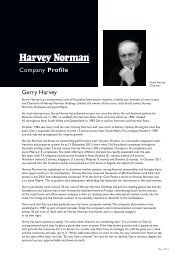annual report - Harvey Norman Company Reports & Announcements
annual report - Harvey Norman Company Reports & Announcements
annual report - Harvey Norman Company Reports & Announcements
You also want an ePaper? Increase the reach of your titles
YUMPU automatically turns print PDFs into web optimized ePapers that Google loves.
STATEMENT OF SIGNIFICANT ACCOUNTING POLICIES (CONTINUED)<br />
(x) Impairment of non-financial assets (continued)<br />
The consolidated entity bases its impairment calculation on detailed budgets and forecast calculations, which are<br />
prepared separately for each of the consolidated entity‟s CGUs to which the individual assets are allocated. These budgets<br />
and forecast calculations generally cover a period of five years. For longer periods, a long-term growth rate is calculated<br />
and applied to project future cash flows after the fifth year.<br />
Impairment losses of continuing operations, including impairment on inventories, are recognised in the income statement in<br />
expense categories consistent with the function of the impaired assets, except for a property previously revalued and the<br />
revaluation was taken to other comprehensive income. In this case, the impairment is also recognised in other<br />
comprehensive income up to the amount of any previous revaluation.<br />
For assets excluding goodwill, an assessment is made at each <strong>report</strong>ing date whether there is any indication that previously<br />
recognised impairment losses may no longer exist or may have decreased. If such indication exists, the consolidated entity<br />
estimates the asset‟s or CGUs recoverable amount. A previously recognised impairment loss is reversed only if there has<br />
been a change in the assumptions used to determine the asset‟s recoverable amount since the last impairment loss was<br />
recognised. The reversal is limited so that the carrying amount of the asset does not exceed its recoverable amount, nor<br />
exceed the carrying amount that would have been determined, net of depreciation, had no impairment loss been<br />
recognised for the asset in prior years. Such reversal is recognised in the income statement unless the asset is carried at a<br />
revalued amount, in which case, the reversal is treated as a revaluation increase.<br />
(xi) Financial instruments – initial recognition and subsequent measurement<br />
Financial Assets<br />
Financial assets in the scope of AASB 139 Financial Instruments: Recognition and Measurement are classified as either<br />
financial assets at fair value through profit or loss, loans and receivables, held-to-maturity investments, or available-for-sale<br />
financial assets. The consolidated entity determines the classification of its financial assets at initial recognition.<br />
All financial assets are recognised initially at fair value plus transaction costs, except in the case of financial assets recorded<br />
at fair value through profit or loss.<br />
All regular way purchases and sales of financial assets are recognised on the trade date i.e. the date that the consolidated<br />
entity commits to purchase the asset. Regular way purchases or sales are purchases or sales of financial assets under<br />
contracts that require delivery of the assets within the period established generally by regulation or convention in the<br />
market place.<br />
The consolidated entity‟s financial assets include cash and short-term deposits, trade and other receivables, loans and<br />
other receivables, quoted financial instruments and derivative financial instruments.<br />
The subsequent measurement of financial assets depends on their classification as described below:<br />
Financial assets at fair value through profit or loss<br />
Financial assets classified as held for trading are included in the category „financial assets at fair value through profit or loss‟.<br />
Financial assets are classified as held for trading if they are acquired for the purpose of selling in the near term with the<br />
intention of making a profit. Derivatives are also classified as held for trading unless they are designated as effective<br />
hedging instruments. Gains or losses on investments held for trading are recognised in profit or loss.<br />
Held-to-maturity investments<br />
Non-derivative financial assets with fixed or determinable payments and fixed maturity are classified as held-to-maturity<br />
when the consolidated entity has the positive intention and ability to hold to maturity. Investments intended to be held for<br />
an undefined period are not included in this classification. Held-to-maturity investments are recorded at amortised cost<br />
using the effective interest method less impairment with revenue recognised on an effective yield basis.<br />
Loans and receivables<br />
Loans and receivables including loan notes and loans to key management personnel are non-derivative financial assets<br />
with fixed or determinable payments that are not quoted in an active market. Such assets are carried at amortised cost<br />
using the effective interest method. Gains and losses are recognised in profit or loss when the loans and receivables are<br />
derecognised or impaired, as well as through the amortisation process. Interest income is recognised by applying the<br />
effective interest rate.<br />
62



